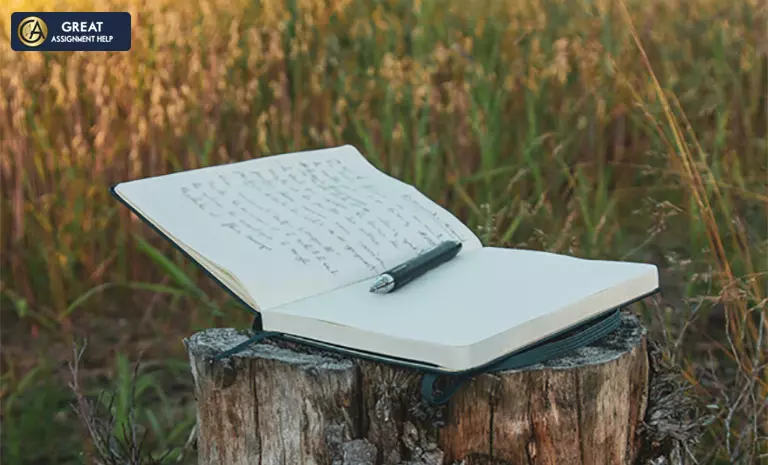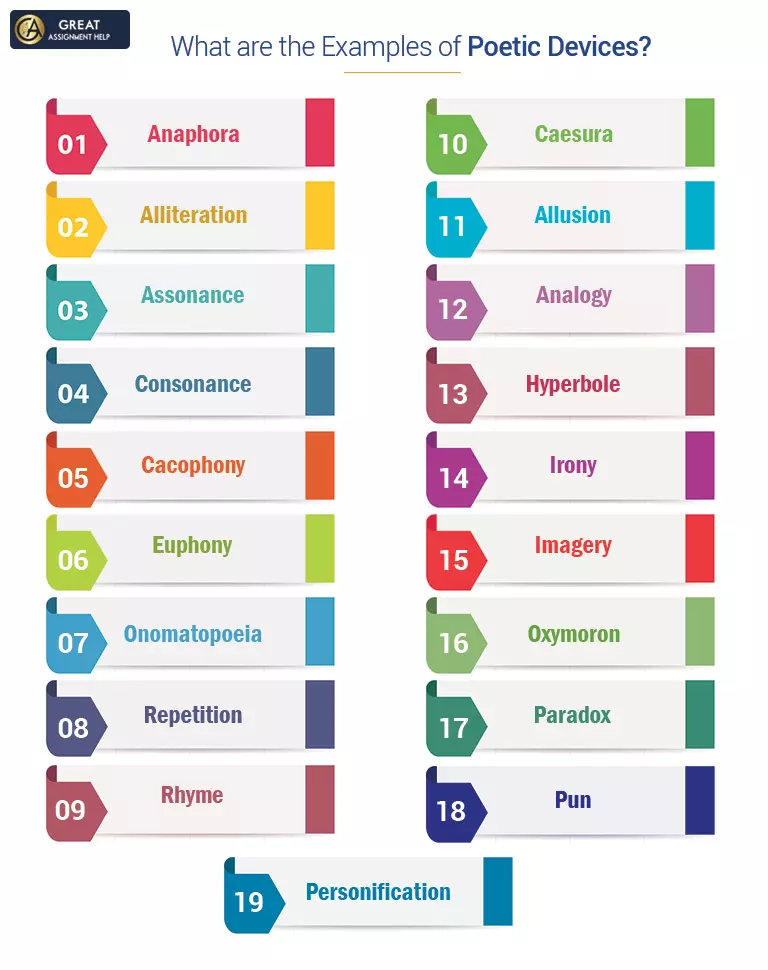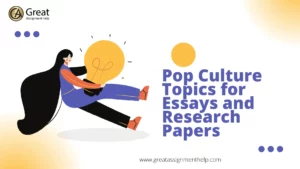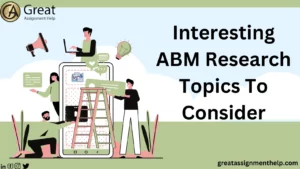English is a beautiful language that contains several literary techniques, jargon, and elements to make a narration more impressive. Most importantly, based on the different cultures of people, the history of English is also facing several modifications continuously. Out of them all, in English, especially to ease communication and develop various compositions, many literary devices and concepts were introduced. Poems are one of the expression forms that use a lot of poetic devices to convey a message and feelings more rhythmically and expressively. In this blog, we will have a look at the 20 most important poetic devices in English Literature with examples.
What are Poetic Devices?
A poetic device is a form of literary device that is predominantly used in poetry. Similar to verbs, visual, rhythmic, structural, grammatical elements, and so on, poetic devices are also used as one of the elements in a poem. The majority of the poets use poetic devices as a tool to augment a poem’s meaning and to intensify the core emotion, feeling, and mood of a poem in a rhythmically pleasing manner.
Read more: LONGEST ENGLISH WORD
List of Common Poetic Devices You Should Know
In a poem, different types of poetic devices can be incorporated. But in general, a lot of forms of poetic devices are used to
- Add sounds of words.
- Arrange the words in a particular order or sequence.
- Enhance the meaning of words.
- Build imagery through words.
The following are the most commonly used poetic devices in English literature that you must know about.
20 Poetic Devices with Examples
Here, let us learn about the purpose of 20 interesting poetic devices with examples.
1. Anaphora
To illustrate, an anaphora indicates a poem that repeats a phrase at the start of each line. Frequently, it’s the core component of the poem’s development and in other cases, it’s used in one or two paragraphs. However, it’s not applied to the entire piece poem.
Example: I am a feather in the bright sky
I am the blue horse that runs in the plain
Precisely, the poem “The Delight Song of Tsoai- tale” by N.Scott Momaday is an experiment of metaphor. Also, the easy “I am “anaphora drives the audience’s attention towards the increasing need of the poet to describe himself.
2. Alliteration
Simply, alliteration is the repetition of a continuous sound at the start of 2 or more subsequent words. Perhaps, alliteration is a strong and subtle way of regulating the poem’s mood. For instance, a range of “s’s” words might make your poem sneaky, sharp, and sinister. On the other hand, a series of b’s, ds, and p’s might give your poem a persuasive or heavy sound. Moreover, this sounds like beating sticks on a drum.
Example: Lord Ullin’s daughter
“His horsemen hard behind us ride;
Should our steps discover,
Then who will cheer my bonny bride
When they have slain her lover/”
Subsequently, this example focuses on words like his horsemen and hard. Moreover, you will identify the “h” sound in three continuous sentences.
3. Assonance
Besides, assonance portrays the iteration of the vowel sound in specific sentences. Despite its complexity, assonance is identified regularly in modern poetry.
Example: Poem – The Duck and the Kangaroo
“Good gracious! How you hop!
Over the fields and the water too:”
Consequently, in the above poem, you may find the iteration of the “o” vowel in words like good, you, hop, and too.
4. Consonance
Alternatively, consonance demonstrates the iteration of consonant sounds in specific sentences. Perhaps, the repetition is either identified at the start or the middle of specific sentences. Let’s understand the same through the example below.
Example: Poem – The Tyger
“Tyger Tyger, burning bright,
In the forests of the night;
What immortal hand or eye,
Could frame thy fearful symmetry”
To illustrate, check the consonant “r” sound in each line of the given stanza.
5. Cacophony
Subsequently, the cacophony communicates the disorder message by providing a range of unpleasant and hard sounds. Consequently, poems that master musicality might sound cacophonous. Though a cacophony sounds unpleasant, its impact isn’t unpleasant for the readers. Generally, a cacophony happens, when the poet uses a rude sound repeatedly.
Example: Poem – Jabberwocky
“Twas brillig, and the slithy toves
Did gyre and gimble in the wave;
All mimsy were the borogoves, an
And the mome raths outgrabe.
Beware the Jabberwock, my son!
The jaws that bite, the claws that catch!
Beware the Jubjub bird, and shun
The frumious Bandersnatch!”
Did you identify any unpleasant or nonsense sounds in the above example? If yes, perhaps you have understood what cacophony is.
6. Euphony
Generally, euphony is one such poetic device that sounds pleasant to the ears of the readers. Unlike a cacophony, the flow of euphony is pleasant as well as sounds sweet.
Example: Poem – To Autumn
“Season of mists and mellow fruitfulness,
Close bosom-friend of the maturing sun;
Conspiring with him on how to load and bless
With fruit, the vines that round the thatch-eves run”
Mostly, you may find few simple words that sound like a melody in the above stanza.
7. Onomatopoeia
If you want to create a dramatic effect, certainly you ought to use the right set of words. Let’s look at the example below and understand how onomatopoeia works.
Example: Poem- The Brook
“I chatter over stony ways,
In little sharps and trebles,
I bubble into eddying bays,
I babble on the pebbles.”
Did you notice the dramatic effect in the above stanza? To illustrate, words like chatter, trebles, bubble, and pebbles explain the summer season. Moreover, they establish a significant effect of flowing water in the poem.
Let’s further explore the sounds that might create a dramatic effect on a poem.
| Water Sounds | Collision Sounds | Air Sounds | Animal Sounds |
| Drip | Click | Waft | Meow |
| Sprinkle | Clap | Gasp | Bark |
| Drizzle | Bang | Flutter | Quack |
| Dribble | Thud | Whizz | Cluck |
| Squirt | Clatter | Whisper | Hiss |
| Clank | Whip | Cuckoo | |
| Slap | Swoosh | Purr |
8. Repetition
Frequently, repetitions occur to highlight a specific scenario. Occasionally, it’s applied to make poems more appealing as well as attractive. Usually, repetitions take place in children’s poems and thereby drive the reader’s attention.
Example: Poem – The Green Grass grows all around
“There was a tree
All in the wood
The prettiest tree
That you ever did see
The tree in a hole
And the hole in the ground
And the green grass grows all around, all around
The green grass grows all around”
Consequently, words like “green grass” and “tree” display the right motto to all children.
9. Rhyme
Another, important type of poetic device is the rhyme which establishes a musical effect through the right sets of words. Moreover, two types of rhymes exist in poems that we ought to explore in the following paragraphs. However, before, we go any further, let’s explore one general example of a rhyme.
Example: Poem – The Rime of the Ancient Mariner
“The ship was cheered, the harbor cleared,
Merrily did we drop
Below the Kirk, below the hill,
Below the lighthouse top”
Did you find the rhymes examples in the above stanza? Of course, cheered-cleared and drop-top is your answer.
· Internal Rhyme
Precisely, internal rhyme happens in the same line of a poem, for instance, words like “dreary” and “weary” demonstrate internal rhyming. Let’s check it below:
“Once upon a midnight dreary, while I pondered, weak and weary”
· End- Rhyme
Generally, it happens when two words are used in the same line and generate the same sound.
For example: “A word is dead
When it is said”
Thus, words like dead and said demonstrate the end rhyme in the same sentence.
10. Caesura
Do you speak without a break? Of course not, then how may you write a poem without giving a pause? Thus, caesura demonstrates a pause in the rhythm of the poems.
Example: Poem – The Star-Spangled Banner
“Oh, say can you see II by the dawn’s early light,
What so proudly we hailed II as the twilights last gleaming?
Whose broad stripes and bright stars II through the perilous fight,
O’er the ramparts we watched II were so gallantly streaming”
Did you notice the bold words in the above stanza? If yes, then start reading the stanza and use the bold words as a pause.
11. Allusion
Simply, an allusion serves as an indirect reference to a character, person, art, historical events, or even mythological situations. In a nutshell, it briefly describes the above-mentioned things.
For example, “The Cunninghams are country folks, farmers, and the crash hit them hardest”.
Perhaps, in the above line, the poet indirectly talks about the stock market, while he uses the phrase “crash hit”. Hence, this sentence is an allusion.
12. Analogy
Subsequently, an analogy communicates the poet’s message by comparing two different situations. Moreover, it supports the readers to understand the link between different or similar situations.
Let’s now explore the different types of analogies that might help you to fare well in competitive exams.
- Simile- Simply, a simile compares two words, using the words like “as” or “like”.
- Metaphor- Unlike a simile, it compares two words, however, it doesn’t use words like “as” or “like”.
- Allegory- In short, an allegory describes a person, event, or symbol and might describe political or historical situations.
- Parable- Similar to an allegory, however, it presents the story with educational lessons or even principles.
- Exemplification- Generally, it describes the connection between a sample and what it states.
What are examples of Analogy?
- As light as a feather.
- Sly like a fox.
- As happy as a clam.
- Busy like a bee.
- As quiet as a mouse.
Further, you may explore below to understand the examples of kenning, marked in bold.
1. “There was Shield Sheafson, the scourge of many tribals,
A wrecker of mead benches, rampaging among foes.
This terror of the hall troops had come far.”
2. “As his powers waxed and his worth was proved.
In the end each clan on the outlying coasts
Beyond the whale-road had to yield to him
And begin to pay tribute. That was one good king.”
13. Hyperbole
Simply, hyperbole explains the disgraceful exaggeration of an effect that pays attention to the practical context. Also, in Greek, it’s called overcasting.
Example: “Ride ten thousand days and nights,
Till age snow white hairs on thee,”
If you consider “ten thousand days and nights” certainly it’s not a normal situation. Hence, the above stanza demonstrates an exaggeration.
14. Irony
Generally, irony explains a contradictory situation that compares reality and what seems true. Let’s explore a few lines from the play “Romeo and Juliet” and understand the irony better.
“Go ask his name: if he is married.
My grave is like to be my wedding bed.”
If you read the line’s rights, perhaps you will understand what irony is. To clarify, the lines describe a situation, where the speaker states that she will die if she finds the man married.
15. Imagery
Usually, imagery provides a visual representation of a situation and does not describe the real condition. Moreover, it inculcates a feeling in the poem and develops a sensory effect.
Example: Poem – I Wandered Lonely as a Cloud
“I wandered lonely as a cloud
That floats on high o’er vales and hills,
When all at once I saw a crowd,
A host of golden daffodils;”
Mostly, in the above stanza, William Wordsworth shares his feeling through the components of nature.
16. Oxymoron
Subsequently, an oxymoron creates a link between the contradicting words. Moreover, oxymoron words don’t contradict each other, but they depict different meanings.
Example: All the politicians agreed to disagree.
To illustrate the bold words the above are an oxymoron, so if you find it, perhaps you understood it right.
17. Paradox
Simultaneously, a paradox explains the opposite of expectations, existing beliefs, or even perceived opinions.
Example: “The child is a father of the man…”
Though the sentence seems incorrect, it has a core meaning attached to it.
18. Pun
In brief, a pun depicts the word games that share different meanings and generate similar sounds.
Example: “I can’t remember which state my wife wanted to visit for our next vacation — it’s OK, Alaska.”
So, if you read the sentence right, possibly you will understand the joke in “Alaska”. To clarify, it sounds as if I will ask her.
19. Personification
Simply, personification compares non-living objects to human beings. Also, it enables the readers to understand the true message of the poem.
Example: Poem – The Song of the Rain
“I have dotted silver threads dropped from heaven
By the gods. Nature then takes me, to adorn
Her fields and valleys.”
Did you find any personification here? To illustrate the poet compares the rain to silver threads that come from heaven.
20. Euphemism
Euphemism is the act of replacing an offending or unpleasant term with a less hurtful or pleasing term. When writing and speaking, in place of harsher language, euphemisms will be frequently employed.
Example
If I pass during some nocturnal blackness, mothy and warm,
When the hedgehog travels furtively over the lawn,
One may say, “He strove that such innocent creatures should come to no harm,
But he could do little for them, and now he is gone. – Thomas Hardy
Read more: AN UNDERSTANDING OF THE LANGUAGE FEATURES AND STRUCTURAL FEATURES
Benefits of Using Poetic Devices
Poetic devices are essential literary tools that are mainly used to beautify the meaning and enhance the emotional feeling of a poem. Moreover, it has the power to mesmerize the readers. Here, let us have a look at the major reasons why poetic devices are used.
- Using sounds, rhyming words, etc, adds rhythm and tone to a poem.
- With elements such as metaphors, natural imagery, etc, the poetic devices enhance the imagery in a poem.
- The Poetic devices use personification, irony, and so on to improve or intensify a certain feeling in the poem.
- By using elements such as similes, metaphors, allusion, etc, the poetic devices make a poem more meaningful.
- Gives structure to a poem with stanzas, ballet, sonnet, etc.
The Bottom Line
In this blog, so far, we have seen the most common types of literary devices used in poetry with examples, nevertheless, there are countless poetic devices that we were unable to address, such as zeugma, litotes, and epistrophe, to mention a few. The more poetry you read, and the more interested you are in it, the faster you will notice the creative use of poetic devices. Once you get a good understanding of poetic devices, it might become easy for you to use them in the poem you compose. Never overuse poetic devices in your writing. In case, you have any doubts on how, when, and where to use poetic devices, approach the skilled literary assignment experts from our team for clarifications.




